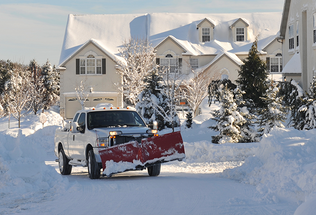Posted by Eric Estes on Aug 18th 2022
5 Pro Tips for Snow Stake and Driveway Markers
Each winter, when the snow falls, the plows come out.
But before it starts snowing, your first task is to plant your snow stake markers. Taking such precautions helps you avoid damaging your equipment and your clients' property.
Having spent years running a successful landscape maintenance and plowing operation, here are our top tips for professional plow teams that want to create the most efficient and effective marking and plowing process.
Tip #1: Ditch the Wooden or Fiberglass Snow Stakes
Historically, snow removal operations have relied on wood or fiberglass stakes for their driveway markers. But those are difficult to install and wear out quickly. They’re neither resilient to cold temperatures nor blunt force trauma, which leaves them prone to splintering, cracking, or breaking.
While fiberglass may be an upgrade compared to wood, it’s especially hazardous if it breaks into tiny splinters. And the last thing you want is a lawsuit on your hands.
Tip #2: Bright Colors Prevent Accidents
Visibility is a significant issue for plow operators, especially if it’s snowing, the sun is in your eyes, or if you operate at nighttime.
Black or brown stakes won’t do, even if they have reflective surfaces. When you shop for the best stakes, you need to have bright high-vis colors that pop no matter the conditions.
Also, you can use different colors to identify various hazards. For instance, you could use red markers for fire hydrants.
Tip #3: How Many Snow Stakes You Should Use
The proper amount of snow stakes on a particular property varies. Generally speaking, one stake every 15 feet should suffice. However, there are other mitigating factors to consider, such as:
●New vs. old account – For new accounts, the more stakes the better. As you grow more accustomed to plowing their property, you can scale back.
●Curved vs straight driveway – A straight driveway is easier to plow, so it requires fewer stakes. For nonlinear driveways, you’ll need to place more markers on the key points of the curve.
●Commercial vs residential – Commercial properties tend to require more snow stakes than residential properties. But that will largely depend on factors like:
○The shape of the commercial property
○Its specific hazards
○The property manager’s preferences
Tip #4: When’s The Best Time to Place Snow Stakes?
Although you could wait for the snow to fall, it’s often easier to start marking properties in mid-October when the ground hasn’t fully frozen in most areas.
For higher traffic areas, particularly schools, kids have been known to misappropriate markers for makeshift swords! As such, it may be better to wait until the first couple of inches of snow have fallen to stake well-trodden paths.
Tip #5: How to Install Snow Stakes the Right Way
Most stake installation methods are time-consuming. Whether it’s cordless drills, a screwdriver and a mallet, or a fence post-pounder, the old ways just don’t work very well.
That’s why we designed a better methodology. With the help of our patented installation tool, there’s no need to drill or pound. Simply:
●Slide the stakes into the installation tool
●Push the staking tool into the ground
●Remove the tool to reveal the stake
With Plow Right Marking Stakes, it’s easy as one, two, three.
Plow Right Marking Stakes: A Revolutionary Installation Tool
When the time comes to plow, the best way to protect your equipment and your client’s property is by following the tips above and using Plow Right’s Marking Stakes.
Our markers are designed for all conditions and come in a variety of high-vis colors. They’re cheaper, more durable, and easier to install than traditional markers.
Shop our products for happy plowing!

